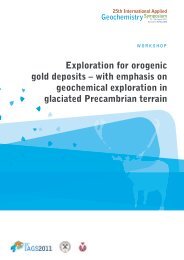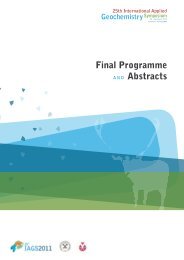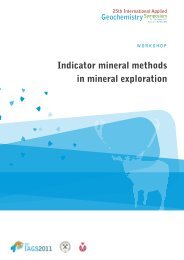IOCG and Porphyry-Cu deposits in Northern Finland ... - IAGS 2011
IOCG and Porphyry-Cu deposits in Northern Finland ... - IAGS 2011
IOCG and Porphyry-Cu deposits in Northern Finland ... - IAGS 2011
Create successful ePaper yourself
Turn your PDF publications into a flip-book with our unique Google optimized e-Paper software.
Group <strong>in</strong> the Gällivare area is also considered to be<br />
equivalent to the Sammakkovaara Group <strong>in</strong> the Pajala<br />
area <strong>and</strong> is dom<strong>in</strong>ated by <strong>in</strong>termediate volcaniclastic<br />
rocks <strong>and</strong> epiclastic sediments. In the Kiruna<br />
area, these volcanic <strong>and</strong> sedimentary units are overla<strong>in</strong><br />
by the Kiirunavaara Group that is followed by<br />
the Hauki <strong>and</strong> Maattavaara quartzites constitut<strong>in</strong>g<br />
the uppermost Svecofennian units <strong>in</strong> the area.<br />
In northern F<strong>in</strong>l<strong>and</strong>, pelitic rocks <strong>in</strong> the<br />
Lapl<strong>and</strong> Granulite Belt were deposited after 1.94<br />
Ga (Tuisku & Huhma 2006). Svecofennian units<br />
are ma<strong>in</strong>ly represented by the Kumpu Group <strong>in</strong> the<br />
CLGB (Lehtonen et al. 1998) <strong>and</strong> by the Paakkola<br />
Group <strong>in</strong> the Peräpohja area (Perttunen & Vaasjoki<br />
2001). The molasse-like conglomerates <strong>and</strong> quartzites<br />
compris<strong>in</strong>g the Kumpu Group were deposited <strong>in</strong><br />
deltaic <strong>and</strong> fluvial fan environments after 1913 Ma <strong>and</strong><br />
before c. 1800 Ma (Rastas et al. 2001). The Kumpu<br />
rocks apparently are equivalent to the Hauki <strong>and</strong><br />
Maattavaara quartzites, <strong>and</strong> Porphyrite Group rocks<br />
<strong>and</strong> the Kurravaara Conglomerate of the Kiruna area.<br />
With the present knowledge of ages <strong>and</strong> petrochemistry<br />
of the Porphyrite <strong>and</strong> Kumpu Groups,<br />
it is possible to attribute these rocks completely to<br />
the same event of collisional tectonics <strong>and</strong> juvenile<br />
convergent marg<strong>in</strong> magmatism. This period of convergence<br />
was manifested by the numerous <strong>in</strong>trusions<br />
of Jörn- (south of the craton marg<strong>in</strong>) <strong>and</strong> Hapar<strong>and</strong>a-<br />
(with<strong>in</strong> the craton) type calc-alkal<strong>in</strong>e <strong>in</strong>trusions, as<br />
described by Mellqvist et al. (2003). With<strong>in</strong> a few<br />
million years, this period of convergent marg<strong>in</strong> magmatism<br />
was followed by a rapid uplift recorded <strong>in</strong><br />
extensive conglomeratic units, more alkal<strong>in</strong>e <strong>and</strong><br />
terrestrial volcanism (Vargfors-Arvidsjaur Groups<br />
south of the craton marg<strong>in</strong> <strong>and</strong> the Kiirunavaara<br />
Group with<strong>in</strong> the craton) <strong>and</strong> plutonism (Gallejaur-<br />
Arvidsjaur type south of the craton marg<strong>in</strong>, Perthite<br />
Monzonite Suite with<strong>in</strong> the craton). This took place<br />
between 1.88 <strong>and</strong> 1.86 Ga <strong>and</strong> the ma<strong>in</strong> volcanic<br />
episode probably lasted less than 10 million years.<br />
The evolution after c. 1.86 is ma<strong>in</strong>ly recorded<br />
by an extensive S-type magmatism (c. 1.85 Ga<br />
Jyryjoki, <strong>and</strong> 1.81–1.78 Ga L<strong>in</strong>a-type <strong>and</strong> the Central<br />
Lapl<strong>and</strong> Granitoid Complex) derived from anatectic<br />
melts <strong>in</strong> the middle crust. In the western part of the<br />
shield, extensive I- to A-type magmatism (Revsund-<br />
Sorsele type) formed roughly N-S trend<strong>in</strong>g batholiths<br />
(the Transc<strong>and</strong><strong>in</strong>avian Igneous Belt) coeval with the<br />
S-type magmatism. Scattered <strong>in</strong>trusions of this type<br />
<strong>and</strong> age also occur further east (e.g. Edefors <strong>in</strong> Sweden,<br />
Nattanen <strong>in</strong> F<strong>in</strong>l<strong>and</strong>). The period from c. 1.87<br />
to 1.80 Ga possibly also <strong>in</strong>volved a shift <strong>in</strong> orogenic<br />
vergence from NE-SW to E-W <strong>in</strong> the northern part<br />
of the Shield as suggested by Weihed et al. (2002).<br />
Palaeoproterozoic magmatism<br />
Early rift<strong>in</strong>g <strong>and</strong> emplacement<br />
of layered igneous complexes<br />
The beg<strong>in</strong>n<strong>in</strong>g of the rift<strong>in</strong>g period between 2.51<br />
<strong>and</strong> 2.43 Ga is <strong>in</strong>dicated by <strong>in</strong>trusion of numerous<br />
layered mafic igneous complexes (Alapieti et<br />
al. 1990, Weihed et al. 2005). Most of the <strong>in</strong>trusions<br />
are located along the marg<strong>in</strong> of the Archaean<br />
granitoid area, either at the boundary aga<strong>in</strong>st the<br />
Proterozoic supracrustal sequence, totally enclosed<br />
by Archaean granitoid, or enclosed by a Proterozoic<br />
supracrustal sequence. Most of the <strong>in</strong>trusions<br />
are found <strong>in</strong> W-trend<strong>in</strong>g Tornio-Näränkävaara belt<br />
of layered <strong>in</strong>trusions (Ilj<strong>in</strong>a & Hanski 2005). Rest<br />
of the <strong>in</strong>trusions are found <strong>in</strong> NW Russia, central<br />
F<strong>in</strong>nish Lapl<strong>and</strong> <strong>and</strong> NW F<strong>in</strong>l<strong>and</strong>. These Palaeoproterozoic<br />
layered <strong>in</strong>trusions are characteristic to<br />
northern F<strong>in</strong>l<strong>and</strong> as only one of them, the Tornio<br />
<strong>in</strong>trusion, be<strong>in</strong>g partly on the Swedish side of the<br />
border. Alapieti <strong>and</strong> Laht<strong>in</strong>en (2002) divided the<br />
<strong>in</strong>trusions <strong>in</strong>to three types, (1) ultramafic–mafic, (2)<br />
mafic <strong>and</strong> (3) <strong>in</strong>termediate megacyclic. They also <strong>in</strong>terpret<br />
the ultramafic–mafic <strong>and</strong> the lowermost part<br />
of the megacyclic type to have crystallised from a<br />
similar, quite primitive magma type, which is characterised<br />
by slightly negative <strong>in</strong>itial e Nd values <strong>and</strong><br />
relatively high MgO <strong>and</strong> Cr, <strong>in</strong>termediate SiO 2, <strong>and</strong><br />
low TiO 2 concentrations, resembl<strong>in</strong>g the bon<strong>in</strong>itic<br />
magma type. The upper parts of megacyclic type<br />
<strong>in</strong>trusions <strong>and</strong> most mafic <strong>in</strong>trusions crystallised<br />
from an evolved Ti-poor, Al-rich basaltic magma.<br />
Amel<strong>in</strong> et al. (1995) suggested two age<br />
groups for the <strong>in</strong>trusions for Fennosc<strong>and</strong>ian Shield,<br />
the first with U–Pb ages at 2.505–2.501 Ga, <strong>and</strong> the<br />
second at 2.449–2.430 Ga. All F<strong>in</strong>nish layered <strong>in</strong>trusions<br />
belong to the younger age group. The <strong>in</strong>trusions<br />
were later deformed <strong>and</strong> metamorphosed dur<strong>in</strong>g<br />
the Svecofennian orogeny.<br />
Mafic dykes<br />
Mafic dykes are locally abundant <strong>and</strong> show a variable<br />
strike, degree of alteration <strong>and</strong> metamorphic<br />
recrystallisation which, with age dat<strong>in</strong>g, <strong>in</strong>dicate<br />
multiple igneous episodes. Albite diabase (a term<br />
commonly used <strong>in</strong> F<strong>in</strong>l<strong>and</strong> <strong>and</strong> Sweden for any albitised<br />
dolerite) is a characteristic type of <strong>in</strong>trusions<br />
that form up to 200 m thick sills. They have a coarsegra<strong>in</strong>ed<br />
central part dom<strong>in</strong>ated by albitic plagioclase<br />
<strong>and</strong> constitute laterally extensive, highly magnetic<br />
units north of Kiruna.<br />
Extensive dyke swarms occur <strong>in</strong> the Archaean<br />
doma<strong>in</strong> north of Kiruna; the swarms are dom<strong>in</strong>ated<br />
by 1–100 m wide dykes with a metamorphic m<strong>in</strong>eral<br />
assemblage but with a more or less preserved<br />
igneous texture (Ödman 1957, Mart<strong>in</strong>sson 1999a,b).<br />
The NNE-trend<strong>in</strong>g dykes that are suggested to represent<br />
feeders to the Kiruna Greenstone Group (Mar-<br />
13






